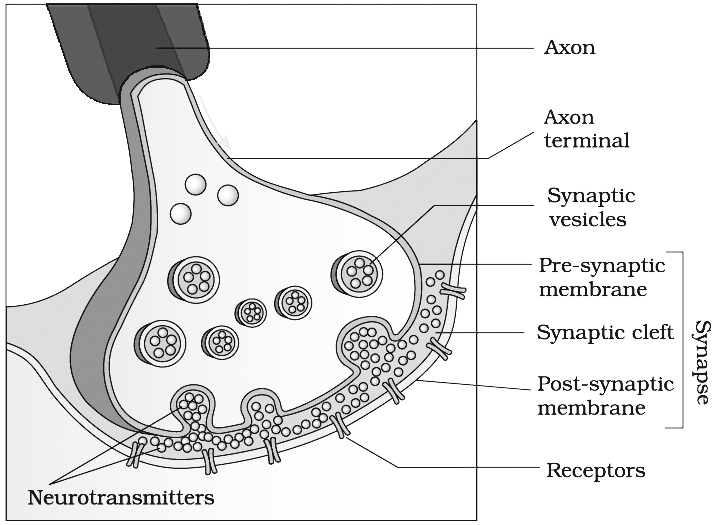- Books Name
- ACME SMART COACHING Biology Book
- Publication
- ACME SMART PUBLICATION
- Course
- CBSE Class 11
- Subject
- Biology
Transmission of impulse
Synapes are the neuroneuronal junctions through which information from one neuron can pass to the other.
There are mainly two types of synapses depending upon the nature of transfer of information across the synapse. (1) Electrical, (2) Chemical
1.Electrical Synapses:
At an electrical synapse, ionic current spreads directly from one cell to another through gap junctions.
Each gap junction contains is hundred or so tubular protein structures called connexons that from tunnel to connect the cytosol of the two cells.
This provides a path for ionic current flow.
Gap junctions are common in visceral (single-unit) smooth muscle, cardiac muscle, and a developing embryo.
They also occur in the CNS.
Electrical synapses have three obvious advantages:
(i) They allow faster communication than do chemical synapses, since impulses conduct across gap junction.
(ii) They can synchronize the activity of a group of neurons or muscle fibers. The value of synchronized action potentials in the heart or in visceral smooth muscles is to achieve coordinated contraction of these fibers.
(iii) They may allow two-way transmission of impulses in contrast to chemical synapses, which function as one way points of communication.
2. Chemical Synapses:
Chemical synapse have 10 to 20 nm gap which is too great a distance for such direct electrical coupling.
Chemical synapses are commonest type of synapse, these consist of a bulbous expansion of a nerve terminal, called synaptic knob, lying in close proximity to the membrane of a dendrite or other part of neuron.
The cytoplasm of the synaptic knob contains numerous tiny, round sacs, called synaptic vesicles.
Each vesicle has a diameter of approximately 50 nm, and contains as many as 10,000 molecules of a neurotransmitter substance responsible for the transmission of nerve impulse across the synapse.
The membrane of the synaptic knob on the axon side, thickened as a result of cytoplasmic condensation, is called presynaptic membrane.
Mechanism of transmission of nerve impulse through chemical synapse
Wave of depolarisation reaches the presynaptic membrane.
3
Voltage-gated calcium channels open, Ca++ ions diffuses into the axon terminal from the surrounding fluid.
3
Ca++ stimulates fusion of synaptic vesicle with pre-synaptic membrane, and release of neurotransmitter by
exocytosis into synaptic cleft.
3
Neurotransmitter bind with specific receptor molecules of post-synaptic membrane.
3
This binding opens sodium ion channels allowing the entry of Na+ ions
which can generate a new potential in the post-synaptic neuron.
3
The new potential developed may be either excitatory or
inhibitory depends upon neurotransmitter.


Concept Builder
1. Acetylcholinestrase is present in the muscle cell or post synaptic neuron. It breaks down acetylcholine into acetate and choline and terminate the action of the transmitter.
2. Nor epinephrine secreted by sympathetic neural system and also by some neurons of central neural system is inactivated by enzyme monamine oxidase.

 ACME SMART PUBLICATION
ACME SMART PUBLICATION
